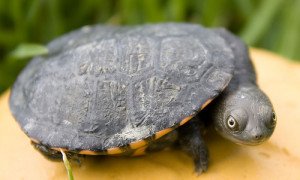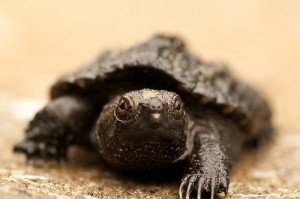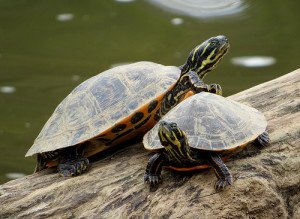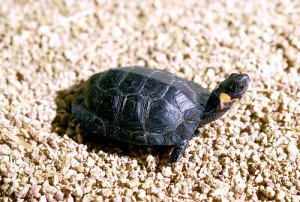 I like box turtles and tortoises, but I have a real soft spot for aquatic turtles.
I like box turtles and tortoises, but I have a real soft spot for aquatic turtles.
Maybe it’s their color, manageable size, or simply all the fond memories I have of stalking them along the waters edge as a kid. Or perhaps it’s their inquisitive nature – like how much it seems they recognize you when you approach with food. Whatever the reason, there’s no doubt that aquatic turtles are among the most popular reptilian pets around.
With so many species of freshwater aquatic turtles, generalizations are not very useful. That’s why we decided to focus on some common freshwater turtle “ecological” groups to give you a flavor of the breadth and depth of this truly wonderful group of animals.
Highly Aquatic Turtles
This ecological group is typified by turtles that rarely emerge from the water to bask, and instead remain underwater nearly all of the time.

Common snapping turtle: Chelydra serpentina
These turtles can and do come out of the water occasionally, but are normally motivated to leave the water out of necessity, such as to lay eggs (in the case of the female) or to migrate from one shrinking body of water to the other. They are very shy and usually do not spend significant time basking during the day. Sometimes, but not always, they will have reduced shell height, a longer neck and more significant webbing of the feet. They are generally speaking not particularly colorful, and often blend in very well with the river, lake or pond bottoms where they spend most of their lives. Most highly aquatic turtles tend to eat more fish than other types, and some have remarkable adaptations for luring and/or capturing fish.
Since they spend relatively little time on land, highly aquatic turtles need a comparatively small land area in captivity. Something that can comfortably support the turtle with a bit of room so it can turn around is usually sufficient. This of course does not apply to breeding these animals, which is beyond the scope of this article.
Some common turtles that fit this description include the common snapping turtle (Chelydra serpentina), alligator snapping turtle (Macrochelys temminckii), the mud turtle (Kinosternon sp.), musk turtles (Sternotherus odoratus), the mata mata (Chelus fimbriata), and African side-necked turtles (Pelusios castaneus).
Basking Turtles

River cooters (Pseudemys concinna) basking.
Unlike the former group, basking turtles spend much of their day out of the water, boldly soaking up the sun around the water’s edge.
These turtles will normally sit on well-lit rocks, logs and quiet stretches of shoreline while maintaining a vigilant eye for danger. They tend to be more colorful than highly aquatic turtles, and usually boast attractive patterns on their head, neck and carapace. Given their greater affinity for land, they also have reduced webbing on their feet and usually have a higher-domed shell. Their diet is also distinctive, as these turtles will often will eat significantly more vegetable matter than highly aquatic turtles, especially when fully mature. Most basking turtles can and will make short overland trips between water bodies if necessary; for example, if their ponds begin to dry. Bu they generally stay in and very close to their preferred basking sites within their home pond, river or lake.
When setting up tanks, remember that these turtles will generally need a larger land area compared to highly aquatic turtles, especially since they will be using this area for basking during much of the day. A land area of anywhere from 25%-50% of the total floorspace of the tank is usually adequate.
These are among the most popular of all aquatic turtles. Common representatives of this group are the red-eared sliders (Trachemys scripta elegans), painted turtles (Chrysemys picta), river cooters (Pseudemys concinna) and map turtles (Graptemys sp.).
Semi-Aquatic Turtles

Threatened bog turtle: Glyptemys muhlenbergii
Semi-aquatic turtles are quite similar to the basking turtles in appearance, and often spend considerable time basking themselves. They also tend to be omnivores, with vegetation being an integral part of the adults’ diet.
However, rather than being closely tied to their water source, they may spend considerable time wandering in moist terrestrial habitats along or between bodies of water, and can often be found quite far from any standing water. When on land, they tend to associate with marshes and other moist habitats typified by a high water table. Unfortunately, given their strong affinity for surrounding terrestrial areas and marshlands, they are highly vulnerable to habitat loss are often among the first species threatened by human encroachment.
Because they are so fond of utilizing land areas, semi-aquatic turtles in captivity should be give a land area that is roughly 50-75% of the total floor area of their enclosure.
Some good examples of semi-aquatic turtles include the wood turtle (Glyptemys insculpta), spotted turtle (Clemmys guttata), Caspian turtle (Mauremys caspica) and the federally-threatened bog turtle (Glyptemys muhlenbergii).
Turtle photo credits (in order of appearance):
Nick Harris under CC BY-ND 2.0
US Fish & Wildlife Service under CC BY 2.0




